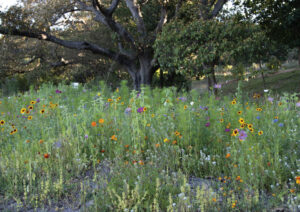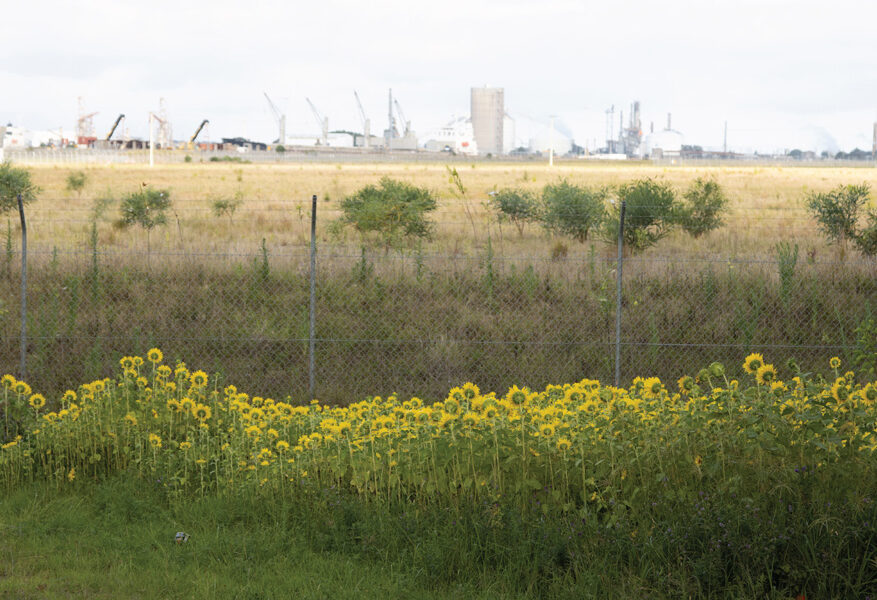Plants to the rescue – cleaning up contaminated sites
By Karen Smith
Delprat Garden, a phytoremediation garden overlooking the site that was once Newcastle’s steel works, was awarded a gold accolade in the architectural design category at the 2023 Australia Good Design Awards and is providing a model for large scale restoration of degraded industrial sites.
The lead Landscape Architect, Professor Sue Anne Ware described the project as a collaboration between University of Newcastle, University of Technology Phytolab Sydney, Landcom, and Newcastle Industrial Heritage Association. Harnessing the power of plants to repair contaminated post-industrial sites was the aim of the project.
Delprat Cottage, the site of the project, was built in 1914 for Guillaume Delprat, the supervisor of the construction of the Newcastle Steelworks. The phytoremediation project is an innovative research-based solution for removing toxic contaminants that have accumulated in the soil during the operation of the Steelworks. A chemical assay of the soil indicated high levels of chromium, lead, zinc and manganese, among other metals. This project follows on from an initial award-winning project at the disused White Bay Power Station at Rozelle, Sydney.

The results of the White Bay project helped determine a range of plants suitable for contaminated sites. Looking at the results for this 2018-19 trial¹ it appears that plants like Marigold Starfire (Tagetes tenuifolia) and Field Mustard (Brassica juncea ) concentrated a range of metals such as selenium, nickel, chromium, lead, manganese, copper, cadmium and vanadium in their biomass. Other plants such as the sunflower (Helianthus annuus) and red clover (Trifolium pratense) performed well for some metals.
Whereas the White Bay project, after the initial planting and nurturing, was left to follow its own wild growth and eventual species loss, the Delprat Garden in Newcastle is a managed garden using a wider range of plants. This garden includes a flower meadow and orchard grove, shrubs, a cottage garden, and a kitchen garden. The kitchen garden is planted with common household vegetables utilising a high turnover of annual and perennial vegetables, and plants such as herbs, tomatoes, varieties of corn, sweet potatoes, and melons to name a few.

The orchard contains various native and exotic tree species such as Backhousia citriodora, red mulberry, Eucalyptus pulverulenta, varieties of magnolia, and angophora. These plantings, both edible and decorative, are tested for concentrations of toxins to determine which vegetables or tree will not contribute to further contamination of the environment. Vegetables grown in contaminated soils could be a contributor to poor health in anyone consuming them. From the results posted on the Delprat Garden website² it appears that pumpkin and beans are good at soaking up most of the metals in the soil at this site and are not likely to be good to eat. There are signs at the Delprat Cottage site warning that plants are unfit for human consumption and not to be touched or eaten. The concentrations of toxins in leaves, fruits, flowers, pollen and seeds could be a risk to the health of the ecosystem affecting insects and grazing animals. However, concentrating soil toxins in the biomass of plants reduces the likelihood of toxins leeching into groundwater or spreading further to pollute other sites.
There are various phases of phytoremediation.
- Phytoaccumulation – where the plants take up and assimilate contaminants.
- Phytovolatilization – where plants release contaminants into the atmosphere.
- Phytodegradation – where plants degrade the contaminants within the plant tissue using enzymes.
- Phytostabilization – where plants absorb and precipitate toxic materials in soils reducing bioavailability, preventing entry into groundwater and food chains.
- Rhizodegradation – where released plant exudates and enzymes stimulate bio-chemical activity enhancing the biodegradation of environmental contaminants.
Orchards and kitchen gardens are not a cost-effective phytoremediation solution for a large, contaminated site such as an open cut coal mine. In fact, some sites might preclude the growing of any edibles for human or animal consumption. The Delprat Cottage meadow is more a solution for broadacre style planting.
Most rehabilitated urban industrial sites have used earthworks where soil is extracted and placed in a toxic landfill and capped with a suitable topsoil. The industrial site is landscaped for some purpose, usually for redevelopment or open space if it is in the middle of one of Australia’s cities.

Most Sydney residents are familiar with the Millenium Park, the site of some of the 2000 Olympic events, and Sydney Park, which was once a brick manufacturing facility, where this method of rehabilitation was used successfully. Every city would have similar examples. This method is extremely expensive and does not easily lend itself to large mine sites.
It is estimated that there are over 15,000 abandoned mine sites in Queensland and up to 50,000 nationally. Of the Queensland sites, only about 35% of mined land has been rehabilitated. The same research group responsible for Delprat Garden estimated that to use these cut and fill methods, the cost of rehabilitation would amount to over 30% of the total income produced by Australia’s coal industry in the past seven years³. Phytoremediation would only cost a fraction of this estimation, although would take longer.
Abandoned mines present significant risks to the environment. Often governments must fund the cleanup because the company responsible can longer be found. The Rum Jungle uranium mine in the Northern Territory made news in 2018 because the original rehabilitation had deteriorated, polluting the nearby Finniss River, and highlighting the complexities and environmental risks of large historical mines. Operating from 1953 to 1971, the Rum Jungle mine produced a reported 3530 tonnes of uranium oxide and 20,000 tonnes of copper concentrate. The Australian and Northern Territory governments are funding a rehabilitation plan that is expected to be a 15-year project.
All states are looking for cost effective methods for rehabilitating degraded industrial and mine sites, and research is continuing. It is essential that as so-called ‘restored’ land is released for re-development or grazing, contaminants have been removed or reduced to safe levels.
References:
¹ https://powerplantsphytoremediation.com/performance_nl
² https://delpratgarden.com.au/garden-performance
³ https://powerplantsphytoremediation.com/phyto-potential-of-abandoned-mines-2
Main photo: Sunflowers performed well at Deprat Gardens for some metals (Image: University of Newcastle)

